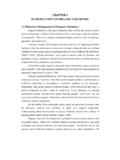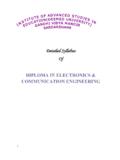Transcription of 1 Introduction 2 Mesons in the Quark Model - curtismeyer.com
1 LIGHT AND EXOTIC Mesons . Curtis A. Meyer Carnegie Mellon University, Pittsburgh, PA 15213. Abstract 1 introduction In this series of lectures I want to provide an overview of the field of light Quark meson spectroscopy. What do we understand about Mesons ? What does studying Mesons tell us about qcd? How do we study Mesons ? Why do we study meson;. what is exciting about this? The area of light Quark meson spectroscopy deals with Mesons built up from u, d and s quarks. Typically, these systems have masses below GeV/c2.
2 2 Mesons in the Quark Model To do this, I want to start with the very basics of the strong interaction, namely the conserved quantities, J, P, C, . With this, I want to look at spectroscopy within one specific Model , the constituent Quark Model . This Model is by no means perfect. It provides no explanation for confinement, and the role of gluons is not obvious. It also makes no absolute mass predictions, and no absolute rate predictions for decays. However it does make a rather large number of very good predictions.
3 It also provides a very natural framework within which to classify Mesons . It provides a natural handle to address issues such as structure and decays, and even makes some rather nice predictions for relative decay rates. The strong interaction conserves a number of quantities, some of which are listed here. B Baryon number. Q Electric charge. J Angular momentum. S Strangeness. I Strong isospin. P Parity. C Charge conjugation. 1. G G parity. Those that are used will be explained as we go along. However, a number of these are carried by the quarks themselves.
4 In table 1 are given the quantum numbers of the three lightest quarks. Quark B Q J S I Iz 1 2 1 1. u 3 3 2. 0 2. + 21. 1. d 3. 13 1. 2. 0 1. 2. 21. 1. s 3. 13 1. 2. 1 0 0. Table 1: Quantum numbers of the quarks. B is baryon number, Q is electric charge, J is the spin, S is strangeness, I is the strong isospin and Iz is the projection of I. along the quantization axis, (usually defined as z). In the constituent Quark Model , we treat a meson as a bound Quark -antiquark pair, q q , and then draw an analogy to the positronium system, e+ e to understand what we are seeing.
5 In this picture the q and the q both have spin 12 . These can combine to either total spin S = 0, or total spin S = 1. 1 1. 1 1 ( 1 2 +. S = 0 ( 1 2 1 2 ) S = 1 2. 1 2 ). 2 1 2. In addition to the total spin, we can have orbital angular momentum L between the q q pair. Then, the L and S can combine to total angular momentum J = L S, where J =| L S |, | L S + 1 |, , | L + S |. The states can be written in spectroscopic notation as 2S+1 LJ , and are shown for positronium in table 2. Using the quarks as given in table 1, we are then able to use L, S and J to construct the JPC quantum numbers of the Mesons .
6 Let us start with parity, P. Mathematically, State S L J P C JPC Mesons Name 1. S0 0 0 0 + 0 + 0 K pseudoscalar 3. S1 1 0 0 1 K vector 1. P1 0 1 1 + 1+ b1 h1 h01 K1 pseudo vector 3. P0 1 1 0 + + 0++ a0 f0 f00 K0 scalar 3. P1 1 1 1 + + 1++ a1 f1 f10 K1 axial vector 3. P2 1 1 2 + + 2++ a2 f2 f20 K2 tensor Table 2: The positronium states as a function of L, S and J. These then correspond to the named Mesons of the specified JPC . 2. parity is a reflection operator, and if the wave functions are eigenstates of the parity operator, then P( (~r)) = ( ~r) = P (~r).
7 Since applying parity twice should return us to the original state, the eigenvalues of parity, P can only be 1. We can normally separate into a radial and an angular piece, (~r) = R(r)Ylm ( , ). In this case, the operation of parity leaves R unchanged, but transforms the angular piece to Ylm ( , + ), and it can be shown that: Ylm ( , + ) = ( 1)l Ylm ( , ). Finally, fermions and antifermions have intrinsic opposite parity. This leads to the parity of a meson being: P(q q ) = ( 1)L+1 (1). In considering that parity is conserved in a reaction, we consider the decay A B+C, where there is orbital angular momentum l between B and C.
8 Parity conservation says that P(A) = P(B) P(C) ( 1)l . (2). The next quantum number is charge conjugation, C, which represents a trans- formation of the particle into its antiparticle. This reverses several properties of the particle such as charge and magnetic moment. Clearly, in order for a particle to be an eigenstate of the C operator, it must be electrically neutral. If we consider the , then: C | >= C | >. where C = 1. If we imagine a meson built from a Quark and its antiquark, say u . u, with some total wave function of both its position and spin.
9 (~r, ~s) = R(r)Ylm ( , ) (~s). The charge conjugation operator acting on this state reverses the meaning of u and u . This has the effect of mapping ~r which points to the Quark into ~r so that it continues to point at the Quark . Under the same arguments that we used in parity, this leads to a factor ( 1)L+1 . This also flips the spin wave functions, leading to a factor of ( 1) for the S = 0 case and a factor of ) + 1) for the S = 1 case. This is a factor of ( 1)S+1 , which when combined with the L factor leads to: C(q q ) = ( 1)L+S (3).
10 Clearly charged particles cannot be eigenstates of C, C | + >= | >. However, if we were to apply the C operator followed by a rotation in isospin, R =. exp(i I2 ) such that | I, Iz > | I, Iz >, then charged particles could be eigenstates of this operator. We define the G parity operator as G = CR, and from this it is 3. easy to show that for a q q system, G = C ( 1)I . These then lead to the following formulas. J=L S (4). P = ( 1)L+1 (5). C = ( 1)L+S (6). G = ( 1)L+S+I (7). Using these relationships to build up possible JPC 's for Mesons , we find that the following numbers are allowed: 0 + , 0++ , 1 , 1+ , 1 , 2 , 2 + , 2++ , 3 , 3+ , 3.







